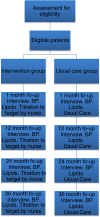The NAILED stroke risk factor trial (nurse based age independent intervention to limit evolution of disease after stroke): study protocol for a randomized controlled trial
- PMID: 23289919
- PMCID: PMC3551832
- DOI: 10.1186/1745-6215-14-5
The NAILED stroke risk factor trial (nurse based age independent intervention to limit evolution of disease after stroke): study protocol for a randomized controlled trial
Abstract
Background: Secondary prevention after stroke and transient ischemic attack (TIA) is essential in order to reduce morbidity and mortality. Secondary stroke prevention studies have, however, been fairly small, or performed as clinical trials with non-representative patient selection. Long-term follow-up data is also limited. A nurse-led follow-up for risk factor improvement may be effective but the evidence is limited. The aims of this study are to perform an adequately sized, nurse-led, long-term secondary preventive follow-up with a population-based inclusion of stroke and TIA patients. The focus will be on blood pressure and lipid control as well as tobacco use and physical activity.
Methods: A randomized, controlled, long-term, population-based trial with two parallel groups. The patients will be included during the initial hospital stay. Important outcome variables are sitting systolic and diastolic blood pressure, LDL cholesterol and total cholesterol. Outcomes will be measured after 12, 24 and 36 months of follow-up. Trained nurses will manage the intervention group with a focus on reaching set treatment goals as soon as possible. The control group will receive usual care. At least 200 patients will be included in each group, in order to reliably detect a difference in mean systolic blood pressure of 5 mmHg. This sample size is also adequate for detection of clinically meaningful group differences in the other outcomes.
Discussion: This study will test the hypothesis that a nurse-led, long-term follow-up after stroke with a focus on reaching set treatment goals as soon as possible, is an effective secondary preventive method. If proven effective, this method could be implemented in general practice at a low cost.
Trial registration: Current Controlled Trials ISRCTN23868518.
Figures
Similar articles
-
Nurse-led, telephone-based secondary preventive follow-up benefits stroke/TIA patients with low education: a randomized controlled trial sub-study.Trials. 2019 Jan 15;20(1):52. doi: 10.1186/s13063-018-3131-4. Trials. 2019. PMID: 30646948 Free PMC article. Clinical Trial.
-
The Nurse-Based Age Independent Intervention to Limit Evolution of Disease After Acute Coronary Syndrome (NAILED ACS) Risk Factor Trial: Protocol for a Randomized Controlled Trial.JMIR Res Protoc. 2014 Aug 15;3(3):e42. doi: 10.2196/resprot.3466. JMIR Res Protoc. 2014. PMID: 25131960 Free PMC article.
-
Long-term, telephone-based follow-up after stroke and TIA improves risk factors: 36-month results from the randomized controlled NAILED stroke risk factor trial.BMC Neurol. 2018 Sep 21;18(1):153. doi: 10.1186/s12883-018-1158-5. BMC Neurol. 2018. PMID: 30241499 Free PMC article. Clinical Trial.
-
Effectiveness of interventions involving nurses in secondary stroke prevention: A systematic review and meta-analysis.Eur J Cardiovasc Nurs. 2018 Dec;17(8):728-736. doi: 10.1177/1474515118779732. Epub 2018 Jun 1. Eur J Cardiovasc Nurs. 2018. PMID: 29856237
-
Rates, Predictors, and Impact of Smoking Cessation after Stroke or Transient Ischemic Attack: A Systematic Review and Meta-Analysis.J Stroke Cerebrovasc Dis. 2021 Oct;30(10):106012. doi: 10.1016/j.jstrokecerebrovasdis.2021.106012. Epub 2021 Jul 27. J Stroke Cerebrovasc Dis. 2021. PMID: 34330020
Cited by
-
Interventions for improving modifiable risk factor control in the secondary prevention of stroke.Cochrane Database Syst Rev. 2018 May 7;5(5):CD009103. doi: 10.1002/14651858.CD009103.pub3. Cochrane Database Syst Rev. 2018. PMID: 29734470 Free PMC article.
-
Orthostatic hypotension in stroke/TIA patients: Association with new events and the effect of the NAILED intervention.PLoS One. 2024 Feb 23;19(2):e0298435. doi: 10.1371/journal.pone.0298435. eCollection 2024. PLoS One. 2024. PMID: 38394187 Free PMC article.
-
Implementation of a new guideline in cardiovascular secondary preventive care: subanalysis of a randomized controlled trial.BMC Cardiovasc Disord. 2016 Apr 30;16:77. doi: 10.1186/s12872-016-0252-0. BMC Cardiovasc Disord. 2016. PMID: 27129980 Free PMC article. Clinical Trial.
-
Prevalence of physical activity and sedentary behavior among stroke survivors in the United States.Top Stroke Rehabil. 2014 May-Jun;21(3):246-55. doi: 10.1310/tsr2103-246. Top Stroke Rehabil. 2014. PMID: 24985392 Free PMC article.
-
Implementation of telephone-based secondary preventive intervention after stroke and transient ischemic attack - participation rate, reasons for nonparticipation and one-year mortality.Cerebrovasc Dis Extra. 2014 Feb 19;4(1):28-39. doi: 10.1159/000358121. eCollection 2014 Jan. Cerebrovasc Dis Extra. 2014. PMID: 24715896 Free PMC article.
References
-
- Furie KL, Kasner SE, Adams RJ, Albers GW, Bush RL, Fagan SC, Halperin JL, Johnston SC, Katzan I, Kernan WN. et al.Guidelines for the prevention of stroke in patients with stroke or transient ischemic attack: a guideline for healthcare professionals from the American heart association/American stroke association. Stroke. 2011;42(1):227–276. doi: 10.1161/STR.0b013e3181f7d043. - DOI - PubMed
Publication types
MeSH terms
Substances
LinkOut - more resources
Full Text Sources
Other Literature Sources
Medical


